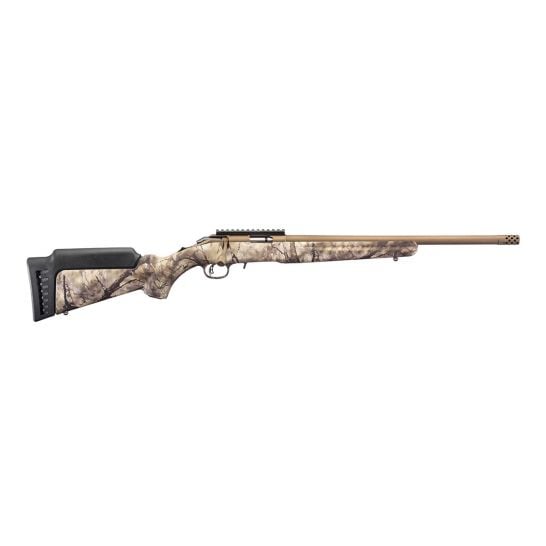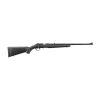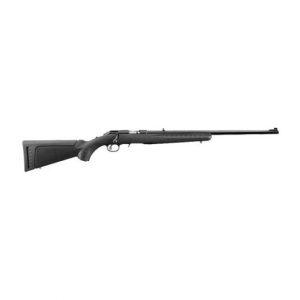Ruger American Rimfire .17 HMR 18" 9 Round Rifle, Go Wild Camo For Sale
$449.99
The Ruger American Rimfire .17 HMR 18″ 9 Round Rifle in Go Wild Camo is a highly versatile and precision-engineered firearm ideal for both experienced and novice shooters. Chambered in .17 HMR, it features an 18″ barrel that delivers remarkable accuracy and performance. Its adaptability is highlighted by an interchangeable high comb stock module, allowing users to adjust for optimal optics use quickly. The lightweight synthetic stock enhances handling and style, with modern contouring and grip serrations. The rifle includes a smooth, extended magazine release for the JMX-1, 9-round rotary magazine and is compatible with the BX-15 Magnum magazine. Ruger’s Power Bedding integral bedding block system stabilizes the receiver and free-floats the barrel, complemented by a customizable Marksman Adjustable trigger. Safety and practicality are key, with an easy-to-use tang safety, a threaded barrel with a muzzle brake, and a receiver-mounted bolt release. The rifle is equipped with a scope rail for easy optical upgrades, and sling swivel studs add mobility convenience. Overall, the Ruger American Rimfire .17 HMR in Go Wild Camo offers a complete shooting system with exceptional performance and user comfort.
What is a .17 HMR good for?
The .17 HMR (Hornady Magnum Rimfire) is a small-caliber rifle cartridge known for its high velocity and flat trajectory. It is particularly good for:
1. **Varmint Hunting**: It is effective for small pests and varmint animals such as squirrels, prairie dogs, and rabbits due to its precision and minimal recoil.
2. **Target Shooting**: The .17 HMR is popular for target shooting because of its accuracy over medium distances, making it suitable for both casual shooting and competitive shooting sports.
3. **Plinking**: Its affordability and low recoil make it a fun and economical option for casual recreational shooting, commonly referred to as plinking.
Overall, the .17 HMR is prized for its accuracy, speed, and flat shooting characteristics, making it a versatile choice for small game hunting and recreational shooting activities.
Does Ruger American Rimfire take 10/22 mags?
Yes, the Ruger American Rimfire rifle is designed to accept Ruger 10/22 magazines.
Which is stronger 17 HMR or 22LR?
The .17 HMR (Hornady Magnum Rimfire) is generally considered stronger than the .22 LR (Long Rifle) in terms of velocity, range, and energy. The .17 HMR typically has a higher velocity (around 2,500 feet per second) and maintains a flatter trajectory over longer distances, making it more suitable for longer-range shooting. It also delivers more energy on impact, which can translate to better performance for certain hunting and target shooting applications. However, the .22 LR is often preferred for its lower cost, availability, and minimal recoil, making it a popular choice for a range of recreational shooting activities.
How accurate is a Ruger American?
The accuracy of a Ruger American rifle is generally considered to be quite good, especially for a firearm in its price range. The Ruger American is known for its affordability and out-of-the-box performance, offering 1-MOA (minute of angle) accuracy or better with good quality ammunition. The rifle features a solid construction with a free-floating barrel and a user-adjustable trigger, which contribute to its consistent performance and accuracy. However, as with any firearm, actual accuracy can depend on various factors such as the specific model, barrel length, ammunition used, and the skill of the shooter.
Is .17 HMR enough for coyotes?
The .17 HMR (Hornady Magnum Rimfire) is generally considered to be on the lighter side for hunting coyotes. While it is possible to take down a coyote with a well-placed shot using a .17 HMR, particularly at closer ranges and with the right bullet choice (such as those designed for expansion), it is not typically recommended as the primary caliber for this purpose. Many hunters prefer larger calibers like the .223 Remington or .22-250 Remington for more consistent and ethical kills on coyotes. It is important to ensure that whatever caliber is used provides a quick and humane kill.
Is a 17 HMR more powerful than a 22 mag?
The .17 HMR (Hornady Magnum Rimfire) and the .22 WMR (Winchester Magnum Rimfire), commonly known as .22 Magnum, are both popular rimfire cartridges, but they have different characteristics and applications.
1. **Velocity and Range**: The .17 HMR typically has a higher velocity than the .22 Magnum due to its smaller, lighter bullet. This higher velocity can result in a flatter trajectory and potentially better accuracy at longer ranges.
2. **Energy**: While the .22 Magnum generally has heavier bullets and can deliver more energy on impact, the .17 HMR’s higher velocity can compensate for its lighter bullet in terms of energy.
3. **Ballistics**: The .17 HMR tends to have better ballistic performance in terms of trajectory and wind resistance due to its higher speed, making it often more suitable for small game hunting at longer distances.
4. **Purpose**: The choice between the two depends largely on intended use. The .22 Magnum may be preferable for slightly larger game due to its greater impact energy, while the .17 HMR is often chosen for its precision and effective range on smaller game.
In summary, whether the .17 HMR is “more powerful” than the .22 Magnum depends on the context of power being considered—kinetic energy or shooting characteristics like velocity and accuracy. Each cartridge has its strengths, and the choice between them should be based on your specific needs and preferences.
Can a Ruger 10 22 take down a deer?
The Ruger 10/22 is a popular .22 caliber rifle primarily designed for small game hunting and target shooting. Its .22 Long Rifle cartridge is generally considered underpowered for ethically hunting and humanely harvesting deer. In many regions, hunting regulations specify minimum caliber requirements for deer hunting, and the .22 LR often does not meet these criteria. It is always important to use appropriate firearms and ammunition for hunting to ensure a humane and legal harvest.
What year did the Ruger American come out?
The Ruger American Rifle was introduced in 2012.
Can you shoot a Ruger 10 22 left handed?
Yes, you can shoot a Ruger 10/22 left-handed. The Ruger 10/22 is a semi-automatic rifle with a design that is generally ambidextrous, meaning it can be used by both right-handed and left-handed shooters. The bolt and ejection port are on the right side, which is common in many rifles, but left-handed individuals often learn to adapt to this setup. However, it’s important for left-handed shooters to be aware of the shell ejection, as spent casings will eject to the right and might come closer to a left-handed shooter’s face. Some left-handed shooters use deflectors or other modifications to make shooting more comfortable, but many are able to shoot the Ruger 10/22 effectively without them.
Will a 17 HMR drop a deer?
The .17 HMR (Hornady Magnum Rimfire) is generally considered too light and insufficient for reliably and ethically hunting deer. It is designed for small game and varmint hunting, such as squirrels and prairie dogs. Deer hunting typically requires a cartridge with more stopping power, such as a .243 Winchester or larger, to ensure a quick and humane kill. Always check local hunting regulations, as they often specify minimum caliber requirements for hunting different types of game.
How far will a 17 HMR shoot accurately?
The .17 HMR (Hornady Magnum Rimfire) is known for its accuracy at short to medium ranges. It is generally effective for small game hunting and target shooting within 150 to 200 yards. Accuracy can vary based on factors such as environmental conditions, the quality of the rifle and optics used, and the shooter’s skill. For most purposes, its optimal range is considered to be up to 150 yards. Beyond that, bullet drop and wind drift become more significant factors.
How much does a 17 HMR drop at 200 yards?
At 200 yards, a .17 HMR bullet typically drops around 8 to 10 inches, depending on various factors such as the specific load, barrel length, and environmental conditions. It’s always best to consult ballistic charts provided by the ammunition manufacturer for more precise data.
Is a 17 HMR good for deer?
No, the .17 HMR (Hornady Magnum Rimfire) is not suitable for hunting deer. It is primarily designed for small game and varmint hunting due to its small caliber and light bullet weight. Hunting deer ethically requires a larger caliber with sufficient energy to ensure a clean and humane kill.
How far will a 17 HMR shoot accurately?
The .17 Hornady Magnum Rimfire (HMR) is generally considered effective and accurate for small game hunting and target shooting at ranges up to about 150 to 200 yards. Beyond this distance, factors like wind drift and bullet drop become more significant, affecting accuracy. The effective range can vary based on shooter skill, environmental conditions, and the specific firearm and ammunition used.
How far does a 17 HMR drop at 200 yards?
The .17 HMR (Hornady Magnum Rimfire) cartridge typically experiences a drop in the range of 8 to 10 inches at 200 yards, depending on factors such as the specific rifle, barrel length, ammunition type, and environmental conditions. It’s always a good idea to verify these figures with ballistics tables or, better yet, through actual field testing with your specific setup.
| Model | American Rimfire Standard Rifle |
|---|---|
| Overall Length | 38.37" |
| Length of Pull | 13.75" |
| Sights | None |
| Stock | Go Wild Camo I-M Brush |
Be the first to review “Ruger American Rimfire .17 HMR 18" 9 Round Rifle, Go Wild Camo” Cancel reply
Related products
Ruger American Rimfire .17 HMR
Ruger American Rimfire .17 HMR Rifle, Synthetic/Blued – Display Model



Reviews
There are no reviews yet.